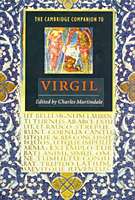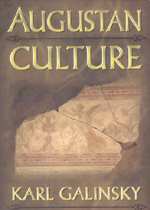 |
||||||||||||||||||||
 | ||||||||||||||||||||
Ed. Charles Martindale Cambridge University Press, 1997. 388pp. 25 halftones. ISBN 0521498856.
This ground-breaking and authoritative volume is an indispensable reference book to accompany the study of Virgil. It is a multi-authored guide aimed at students and anyone with an interest in great literature and the classical heritage. The chapters contain essential information while also offering fresh and original insights into the poems and their author. Emphasis is given to the responses to Virgil over the centuries, particularly by other creative artists. Click here to order.
Contents: 1. Charles Martindale, Introduction: "The classic of all Europe"; Part 1, TRANSLATION AND RECEPTION: 2. Colin Burrow, "Virgil in English translation; 3. Duncan F. Kennedy, "Modern receptions and their interpretative implications"; 4. R. J. Tarrant, "Aspects of Virgil's reception in Antiquity"; 5. Don Fowler, "The Virgil commentary of Servius"; 6. Colin Burrow, "Virgils, from Dante to Milton"; 7. M. J. H. Liversidge, "Virgil in art"; Part 2, GENRE AND POETIC CAREER: 8. Charles Martindale, "Green politics: the Eclogues"; 9. William Batstone, "Virgilian didaxis: value and meaning in the Georgics"; 10. Duncan F. Kennedy, "Virgilian epic"; 11. Elena Theodorakopoulos, "Closure: the Book of Virgil"; Part 3, CONTEXTS OF PRODUCTION: 12. R. J. Tarrant, "Poetry and power: Virgil's poetry in contemporary "; 13. James E. G. Zetzel, "Rome and its traditions"; 14. Susanna Morton Braund, "Virgil and the cosmos: religious and philosophical ideas"; 15. Joseph Farrell, "The Virgilian intertext"; Part 4, CONTENTS AND FORMS: 16. James O'Hara, "Virgil's style"; 17. Dopn Fowler, "Virgilian narrative: (a) Storytelling"; Alessandro Barchiesi, "Virgilian narrative: (b) Ecphrasis"; 18. Andrew Laird, "Approaching characterization in Virgil"; 19. Ellen Oliensis, "Sons and lovers: sexuality and gender in Virgil's poetry"; 20. Philip Hardie, "Virgil and tragedy"; 21. Fiona Cox, "Envoi: The Death of Virgil"; Dateline; Works cited; Index.
Karl Galinsky Princeton University, 1997. 486pp. 174 illus, 8 color plates. ISBN 0691058903 .
Grand political accomplishment and artistic productivity were the hallmarks of Augustus Caesar's reign (31 B.C.. to A.D. 14), which has served as a powerful model of achievement for societies throughout Western history. Although much research has been done on individual facets of Augustan culture, Karl Galinsky's book is the first in decades to present a unified overview, one that brings together political and social history, art, literature, architecture, and religion. Weaving analysis and narrative throughout a richly illustrated text, Galinsky provides not only an enjoyable account of the major ideas of the age, but also an interpretation of the creative tensions and contradictions that made for its vitality and influence. Galinsky draws on source material ranging from coins and inscriptions to the major works of poetry and art, and challenges the schematic concepts and dichotomies that have commonly been applied to Augustan culture. He demonstrates that this culture was neither monolithic nor the mere result of one man's will. Instead it was a nuanced process of evolution and experimentation. Augustan culture had many contributors, as Galinsky demonstrates, and their dynamic interactions resulted in a high point of creativity and complexity that explains the transcendence of the Augustan age. Far from being static, its sophisticated literary and artistic monuments call for the active response and involvement of the reader and viewer even today. Click here to order.
"A thought provoking study that complements and integrates the fruits of many significant studies on individual elements of this major international ancient culture." -- Choice
"An important and fascinating book. The time is right for a work that interweaves Augustan history, literature, and art, and Karl Galinsky is one of the very few scholars who has enough expertise in all three areas to do this successfully... In sum, Augustan Culture is a book that makes the reader think and will help shape Augustan studies for the rest of the decade and well beyond." -- Diana E. E. Kleiner, Yale University
Brooks Otis 1964. Reprinted by University of Oklahoma Press, 1995. 436pp. ISBN 0806127821.
In this classic study, Brooks Otis presents Virgil as a radically different poet from any of his Greek or Roman predecessors. Virgil molded the ancient epic tradition to his own Roman contemporary aims and succeeded in making mythical and legendary figures meaningful to a sophisticated, unmythical age. Otis begins and ends his study with the Aeneid and includes chapters on the Bucolics and the Georgics. A new foreword by Ward W. Briggs, Jr. places Otis's groundbreaking achievement in the context of past and present Virgilian scholarship. Click here to order.
"This is a very careful and perceptive study of the exact nature of Virgil's originality, and his use of hellenistic and classical models to produce something completely unique, a heroic epic in an urban civilization.... [It is] indispensable to all students of Virgil." -- Classical World
"...one of the most formidable and most reliable analyses available on this greatest of Roman poets." -- World Literature Today
"[S]hould form the core of every Vergilian's library." -- Classical Journal
Domenico Comparetti. Tr. E. F. M. Benecke. 1872. Reprinted by Princeton University Press, 1997. 392pp. ISBN 0691026785.
From its first complete Italian printing in 1872 up to the present day, Domenico Comparetti's Vergil in the Middle Ages has been acknowledged as a masterpiece, regarded by some critics as "a true and proper history of European consciousness from antiquity to Dante." Treating Vergil's poetry as a foundation of Latin European identity, Comparetti seeks to give a complete history of the medieval conception of the preeminent poet. Scholars of the time had transformed Vergil into a sage and a seer, a type of universal philosopher--even a Christian poet and a guide of a Christian poet. In the mid-twelfth century, there surfaced legends that converted Vergil into a magician, endowing him with supernatural powers. Comparetti explores the ongoing interest in Vergil's poetry as it appeared in popular folklore and legends as well as in medieval classical scholarship. This great synthesizing work, which has been unavailable for over twenty years, is now back in print, based on E.F.M. Benecke's 1895 translation of the Italian second edition.
Comparetti begins with the period in which Vergil lived and goes on to evaluate how the later images, particularly the legends, of Vergil coincide with the more scholarly accounts of his life. The result is a grand sweep of literary history from the first century BCE. through the end of the Middle Ages, with implications for the nineteenth century and the rise of Italian nationalism. Click here to order.
| ||||||||||||||||||||



